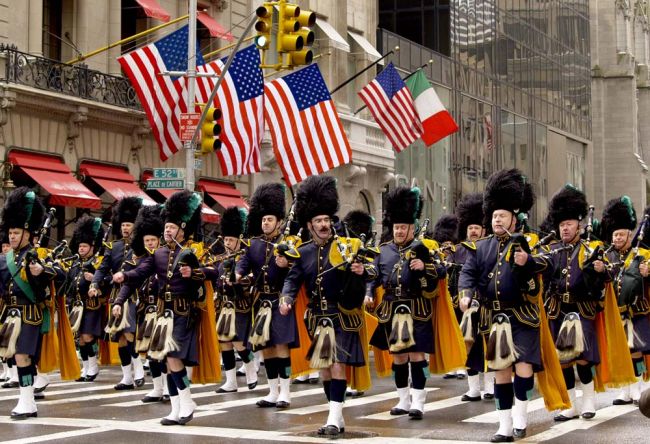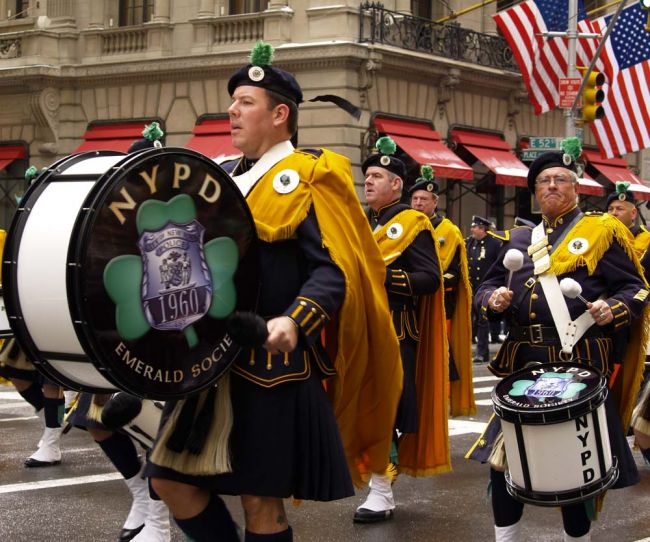| Irish Forums Message Discussion :: St. Patrick. Wearin 'O' the Green Parades. |
   | Irish Forums :: The Irish Message
Forums About Ireland and the Irish Community, For the Irish home and Abroad. Forums include- Irish Music, Irish History, The Irish Diaspora, Irish Culture, Irish Sports, Astrology, Mystic, Irish Ancestry, Genealogy, Irish Travel, Irish Reunited and Craic
|  
|
St. Patrick. Wearin 'O' the Green Parades.
 

|
|
|
| Irish
Author |
St. Patrick. Wearin 'O' the Green Parades. Sceala Irish Craic Forum Irish Message |
BobbyMacQ

Sceala Clann T.D.
Location: Derry roots
|
| Sceala Irish Craic Forum Discussion:
St. Patrick. Wearin 'O' the Green Parades.
|
|
|
Sharing this cool history of St Patrick and the Parades.
The Wearing of the Green
The..Wearing..of..the..Green is an anonymously-penned Irish street ballad dating to 1798. The context of the song is the repression around the time of the Irish Rebellion of 1798. Wearing a shamrock in the "caubeen" (hat) was a sign of rebellion and green was the colour of the Society of the United Irishmen, a republican revolutionary organisation. During the period, displaying revolutionary insignia was made punishable by hanging.
Lyrics
The Wearing of the Green
Many versions of the lyrics exist. The best-known version is by Dion Boucicault, adapted for his 1864 play Arragh na Pogue, or the Wicklow Wedding, set in County Wicklow during the 1798 rebellion. In the second verse, Boucicault's version recounts an encounter between the singer and Napper Tandy, an Irish rebel leader exiled in France. In earlier versions of the ballad, and the similar "Green Among the Cape", it is Napoleon Bonaparte who asks how Ireland is.
Boucicault's addition of the third and last verse is in notable contrast to the middle verse, in advocating emigration to America rather staying in defiance. Boucicault himself fled to New York after leaving his wife for a young actress.
Artists to have recorded the song include John McCormack (1904, again in 1912), Judy Garland (1940), The Wolfe Tones (1985), and Orthodox Celts (1997)
John McCormack The Wearing of the Green

On This Day in History: March 17
Wearin’ O’ the Green
Today is St. Patrick’s Day. St. Pat lived in the fifth century and was responsible for converting many Irishmen to Christianity, though he was not Irish himself. He subsequently became the patron saint of the Irish, and his feast day is celebrated by Irish everywhere.
Bishop Patrick left his home in the Severn Valley, England, and returned to the country where he had once been enslaved. His purpose was to introduce Christianity to the Irish people. Many legends are told about Patrick, including the most famous, that he had charmed all the snakes into the sea, ridding Ireland of them. He was so loved that he was made the Patron Saint of all of Ireland. His day has been celebrated in Ireland on March 17th since the year 461. Today, Saint Patrick’s Day is still a legal, national holiday in Ireland and the north of Ireland.
It is celebrated in New York City like no other place on the globe! That must be true when it is reported that scores of Irish citizens make the trip across the pond just to experience the great way the day is remembered in America.

A Very, Very Special Day for All New Yorkers
The wearing of the three-leaved green shamrock on this day commemorates the saint’s use of this plant to demonstrate the Trinity (3-in-one). New Yorkers have their own unique way of celebrating St. Patrick’s Day. It’s called “wearing o’ the green.” Green clothes, green flowers, and green hats are standard, but you’ll also find unique green beers, green bagels, green water fountains, green face paint, green nail polish and even a green Empire State Building. (Chicago does one better and dyes the Chicago River green!)
First Celebration Outside The Church Observance
On March 17, 1737, in Boston, St. Patrick’s Day was first celebrated outside the confines of the Roman Catholic Church itself. It was held in Boston by the Charitable Irish Society which had been founded that year. The Friendly Sons of St. Patrick in New York City followed suit in 1784. An oddity of the New York society was its joint sponsorship by Irish Roman Catholics and Protestant Presbyterians, with the first president of the organization being a Presbyterian. Talk about democracy at work!
The Greatest Of Parades
This year marks the 244th in Manhattan for the parade known as the world’s largest. The parade will march up Fifth Avenue, clan by clan, from 44th to 86th streets starting at 11 a.m. On March 17, 1766, the first St. Patrick’s Day parade was held in Manhattan by an Irish military unit recruited to serve in the American colonies. The parade continued to be organized each year by military units until after the War of 1812. Then local Irish fraternal and beneficial societies commenced sponsoring the event. The parade was a relatively simple affair in the early 19th century in which members of individual Irish societies joined together at their meeting rooms and moved in a procession toward St. Patrick’s Old Cathedral, St. James Church, or one of the many other Roman Catholic churches in the city.
Starting in 1851, the size of the parade increased sharply, as individual societies merged under a single grand marshal. To preserve the military origins of the parade, each year a unit of soldiers march at the head, followed by the Irish societies of the city. The Irish 69th Regiment (now the 165th Infantry) became the parade’s primary escort unit in the 1850s and the Ancient Order of Hibernians became its chief sponsor. Other major participants in the parade have included the 30 Irish county societies, and the various Emerald, Irish-language, and Irish nationalist societies. Floats, automobiles, and exhibits are not permitted in the parade, in which more than 125,000 marchers take part each year, walking the two-mile green stripe up Manhattan’s Fifth Avenue with another 2 million watching them.
Brooklyn: 1939
On St. Patrick’s Day, 1939, The Brooklyn Eagle in pictures and story reported on the 1,000 members of the Ancient Order of Hibernians who marched from the corner of Kane and Court streets through the Borough Hall and downtown section of Brooklyn to the tunes of more than a score of bands and bugle corps. After the parade in Brooklyn everyone hopped aboard special subway cars for a trip to Manhattan to march as the Brooklyn contingent in the Fifth Avenue parade. In the Eagle photos (see this page) were two pretty Irish lassie drum majors, Evelyn Kuffner and Ella Houser, both of the band of the Charles Heissler Post #179 of the American Legion. Also pictured are Billy Chambers, 2½, and his sister, Marie Ann, 4, of 296 Warren Street carrying Irish flags.
As reported in the 1939 Eagle a 56-year-old Brooklynite, Thomas Kirk, of 2040 E. 26th St., collapsed and died in Manhattan as he sought a place to watch the parade. Meantime in Washington, President Franklin Delano Roosevelt arrived for a press conference dressed in a green ensemble — green tweeds, green tie and shamrock. He opened the conference by inspecting the front row of reporters and, noticing no green except on one newsman, inquired where all the Irishmen were.
FDR and Eleanor also figured in the news as St. Patrick’s Day marked their 34th wedding anniversary. At the wedding in 1905 Eleanor’s uncle, President Theodore Roosevelt, gave her hand in marriage to her fifth cousin. The President sent the First Lady a telegram on the occasion as she was on a lecture tour in the Southwest and scheduled to speak in San Antonio.
Brooklyn: 1942
The Brooklyn Eagle of wartime St. Patrick’s Day, 1942, dealt more with news of World War II as General Douglas MacArthur took over Australia Command on F.D.R.’s orders. But mention was made of Brooklyn’s St. Patrick’s Day parade. William Keating of the Ancient Order of Hibernians led the parade carrying an ancient Irish shillalah. As the parade marched down Court Street, at the corner of Livingston Street, Mrs. Mary Brosnan of 400 Butler St., wearing a Kelly green coat, hat and gloves, lifted aloft 2-year-old speckle-faced Eileen and patted Timothy Jr., 4½, on the head, exclaiming: “There’s your father and a mighty proud man he is today.” Little Eileen, holding an Irish flag, and Timothy, waving the Stars and Stripes, shouted greetings to their pop, one of the marchers at the head of the parade.
by Vernon Parker
|
|
|
|
|
|
|
|
|
|











